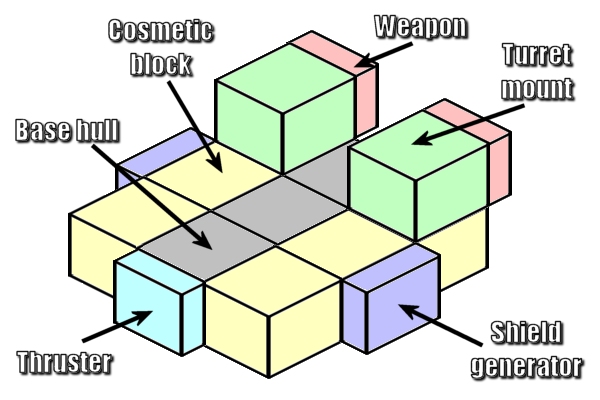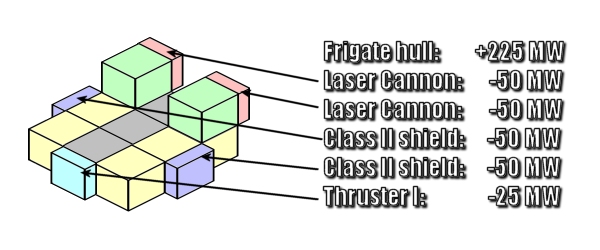One of the things I’m particularly fond of in 4X games is custom ship design, both for cosmetic and gameplay reasons. There’s something special about designing your own ship setup and then testing it out in battle, and I really want to capture that magic in Predestination.
To achieve that, I’m developing a 3D lego style ship designer in which you slot together pre-made blocks to create your own ship designs. Most of the blocks will be purely cosmetic, but some will affect gameplay. You’ll add modules like shield generators, thrusters, weapons, armour plates etc to design your own custom loadout. You’ll also be able to research special mount blocks that give certain module types bonuses or modify their operation in some way, like long range or point defense mounts for weapons. A mock-up of the system is below:
The current design is kind of like lego, with each block having exposed faces that other things can be connected to. For example, you would get corner pieces that connect on three sides, straight pylons that connect on either end, and finishing pieces like spikes that only connect on one side. There will be a number of different hull sizes, with larger ships starting with a larger number of base hull blocks and a larger area in which to design the ship.
Each size of hull will have a fixed power output in MW and each module (weapons, shields etc) you can add to the ship will have a maximum power rating. When you add a module, you’ll set how much power it will draw from the hull, up to the module’s maximum power rating. The more power you draw, the more effective the module is. For example, a Class I shield generator may provide 10 HP per MW and 1 regen/turn per MW, or a laser cannon could provide 1 damage per MW.
Example:
Research:
In 4X games, war is a technological arms race to develop better weapons, defences, sensors and speed than the enemy. Your enemy develops ion cannons, so you need class 3 shields. Your enemy builds ships with neutronium armour and you design a counter-fleet with armour-piercing projectile cannons. You’ll be able to research bigger ships and better weapons, shields and other modules as the game progresses. Bigger hulls will have higher power outputs, and better modules will will have higher maximum power ratings and be more efficient.
For example, laser cannons may have a maximum output of 50MW and an efficiency of 1 damage per MW. You might later research ion cannons with a maximum output of 100MW and efficiency rating of 1.2 damage per MW. In the frigate example above, you could replace the two laser cannons with one 100MW ion cannon, or with two ion cannons downgraded to 50MW. Shield modules will similarly have a maximum hitpoint and recharge rate per MW, thrusters will have speed per MW etc. Other special modules like tractor beams and troop pods will have a fixed energy usage.
Tactical combat:
This ship design process opens up some interesting new gameplay possibilities for tactical combat. You could design a fast ship with no defences to hit the enemy first, or build an artillery ship with no thrusters but a huge tank and long-range weapons. As better weapons have higher maximum power ratings, you’ll eventually need to use larger ships to get the most out of them. This should encourage players to build smaller fleets of larger ships.
Module mounts will add tactical tradeoffs to the modules attached to them and let you mould ships to fit certain roles. Long range heavy weapon mounts would increase the range of the attached weapon but also increase its drain on the ship’s power core, so a 100MW ion cannon would take 150MW to power. Capacitor weapon mounts would half the power drain on the ship’s core but the weapon would only be able to fire every other turn. There are plenty of other possible types of mounts, you could even have them for shields or thrusters.
Next week I’ll have a post up on designs for the tactical space combat that these ships are used in. I’ve been prototyping the tactical combat mechanics using a chess board, and it feels pretty solid. I’m going to start prototyping these systems now in-game.







